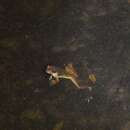en
names in breadcrumbs


Trachycephalus macrotis, also known as the Amazonian milk frog and known in Spanish as rana lechera de Pastaza, is a frog in the family Hylidae. It is endemic to Peru and Ecuador. Scientists have seen it between 225 and 925 m above sea level.[1][2]
The adult male frog measures 69.8 to 91.5 mm in snout-vent length and the adult female frog 93.9 to 118.7 mm. Its head is wider than it is long. It has bronze-colored skin with coffee-colored marks. It has some webbing on its feet and relatively small climbing disks on its toes.[2]
This frog engages in explosive breeding after heavy rain.[2]
Trachycephalus macrotis, also known as the Amazonian milk frog and known in Spanish as rana lechera de Pastaza, is a frog in the family Hylidae. It is endemic to Peru and Ecuador. Scientists have seen it between 225 and 925 m above sea level.
The adult male frog measures 69.8 to 91.5 mm in snout-vent length and the adult female frog 93.9 to 118.7 mm. Its head is wider than it is long. It has bronze-colored skin with coffee-colored marks. It has some webbing on its feet and relatively small climbing disks on its toes.
This frog engages in explosive breeding after heavy rain.